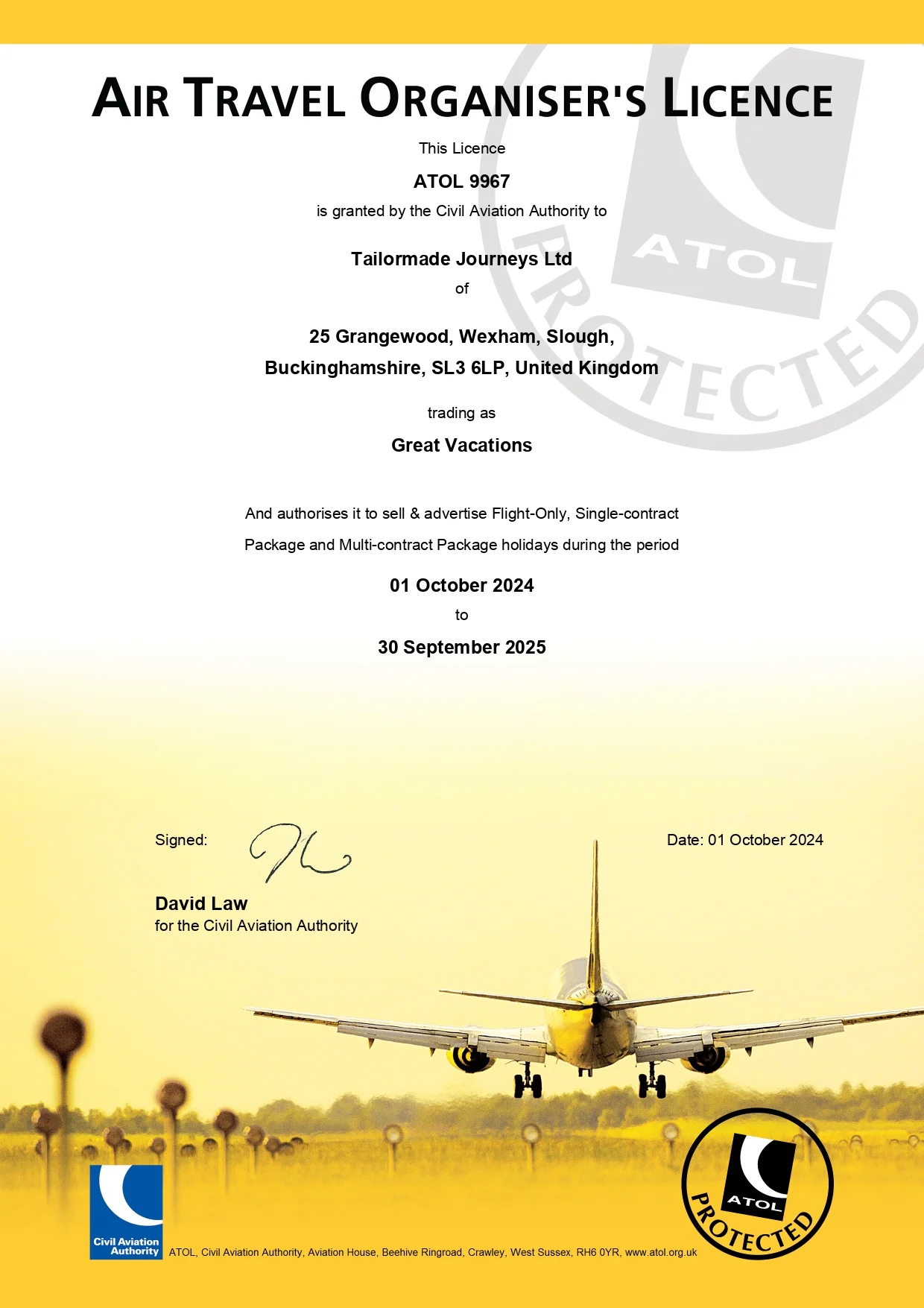
Going on a safari to see the tigers of Ranthambore National Park is an unmissable experience for visitors to Rajasthan. This famous park is not only known for its thriving population of over 60 tigers but also for offering one of the best opportunities in the world to observe these majestic animals in their natural habitat. The tigers at Ranthambore are relatively accustomed to safari vehicles, increasing the likelihood of sightings, especially if you take multiple trips into the park.
Beyond the excitement of tiger tracking, Ranthambore teems with diverse wildlife that adds to the thrill of your safari. Sloth bears amble through the underbrush, monkeys swing between branches, and deer gracefully navigate the terrain. The park’s lakes and wetlands are home to crocodiles basking in the sun, and if you’re lucky, you might even catch a glimpse of the elusive leopard stealthily blending into the rocky landscape.
For an enriched experience, check out our detailed Ranthambore National Park Safari guide. It covers everything you need to know to make the most of your visit, from booking tips to the best times for tiger spotting and practical advice to enhance your safari adventure.
Ways to Reach Ranthambore National Park
To start, let’s talk about reaching Ranthambore. The nearest city is Sawai Madhopur, making it the best base for your visit to Ranthambore National Park. Fortunately, Sawai Madhopur is well-connected by public transport, with direct train services linking it to several major cities, ensuring travel is both convenient and budget-friendly.
Trains are the most straightforward way to get to Ranthambore National Park, with direct connections available from Jaipur, Agra, Jodhpur, Delhi, Udaipur, and other cities. If you’re looking for a luxury experience, consider traveling on the Deccan Odyssey. Be sure to make your Deccan Odyssey booking in advance, as seats on these luxury trains can sell out quickly. We’ve learned from experience that late bookings can force last-minute changes to your plans, so it’s best to reserve early.
If you’re short on time, a day trip from Jaipur to Ranthambore is possible. Just keep in mind that it will be a long day. For a more relaxed and fulfilling experience, staying overnight in Sawai Madhopur is the better option.
Best Time to Visit Ranthambore National Parkheck out our comprehensive Ranthambore National Park Safari guide for everything you need to know, including our top advice for tiger spotting!
Best Time to Visit Ranthambore National Park
There isn’t a guaranteed perfect time for a safari in Ranthambore National Park, as wildlife sightings are unpredictable and often come down to luck. That said, May and June are considered top months for spotting tigers. During these months, temperatures average around 34-35°C, with highs reaching up to 40-41°C. The intense heat drives tigers out of their shelters to drink from lakes and water sources, which boosts your chances of seeing them. However, be prepared to deal with the extreme heat yourself.
Zone 3 is a recommended area to visit during these hotter months, as it includes three lakes, with Padam Lake being the largest. With some luck, you could spot tigers and other wildlife cooling off by the water’s edge.
If the high temperatures seem too challenging, visiting from November to April is another good option. The weather is more pleasant, but you should bring warmer clothing to handle the chill in the mornings and evenings.
October is generally not the best time for tiger sightings, as it follows the monsoon season, which leaves the park with abundant water and reduces the need for animals to gather at the main lakes. Still, we once visited in October and were lucky enough to spot tigers on three out of four safaris.
In the end, tiger sightings can happen any time of the year. The key is to spend enough time in the area and take multiple safaris. With patience and a bit of luck, you’ll have a good chance of spotting a tiger, no matter when you visit.
Ranthambore During the Monsoon Season
Ranthambore National Park typically remains closed during the monsoon months of July, August, and September. This closure is primarily to protect the wildlife during their breeding season and due to the heavy rain that make certain areas difficult to access. The park’s closure during the monsoon helps reduce the stress on the animals and gives them a quieter, more secure environment during a critical time. However, in recent years, zones 6 to 10 have remained open for tourists, while zones 1 to 5 stay closed. This allows visitors to still experience parts of the park during this time, though access is limited.
It’s important to keep in mind that the availability of open zones can vary each year, so it’s always a good idea to check the latest information before planning your visit. The heavy rains can sometimes cause roads in specific zones, particularly in zones 7 and 8, to become impassable. This may lead to temporary closures or restrictions in those areas. To avoid disappointment, it’s always best to confirm the current status of the park’s zones before making travel arrangements, especially if you are planning to visit during the monsoon season.
Jeep vs Canter: Which is the Best Safari Option for Ranthambore National Park?
In Ranthambore National Park, visitors have the option of two types of safaris: jeep safaris and canter safaris. Jeep safaris, also known as gypsy safaris, are smaller vehicles that accommodate up to six people, while canters are larger, seating up to 20 people.
If you’re trying to decide between the two, we highly recommend opting for the jeep safari. Although it’s slightly more expensive, jeeps offer a more comfortable and personal experience. They are more maneuverable, allowing access to areas that larger canters simply can’t reach. On our first safari in Ranthambore, we chose a canter, and while we were fortunate enough to spot a tiger within minutes, the overall experience felt less engaging. With the larger group, the guide had a hard time pointing out specific wildlife, making it difficult to know where to look.
The next three safaris we took were in jeeps, and the difference was clear. The smaller group size allowed the guide to interact more directly with us, pointing out animals and making the whole experience feel more intimate and enjoyable.
While jeep safaris do cost a little more than canters, the price difference is not significant. Given the effort and cost of making the trip to Ranthambore, it’s well worth spending a bit more for a more memorable safari. You can book your jeep safari directly through Deccan Odyssey – booking.
Best Zones for a Memorable Safari at Ranthambore National Park
Ranthambore National Park is divided into 10 zones, with each safari offering access to just one zone at a time. While there’s ongoing debate about which zones are best for spotting the park’s iconic tigers, zones 1 to 5 are often regarded as top choices. However, even these zones don’t guarantee a tiger sighting, as tigers can also be spotted in zones 6 to 10.
The truth is, the “best” zone can vary depending on recent tiger sightings. If a specific zone has had frequent tiger activity in the days leading up to your visit, your chances of spotting one there increase. Because of this, we don’t recommend any particular zone in this guide. The best zone is really based on the most recent activity before your visit.
To secure your preferred zone, it’s important to book your safari well in advance, as there are limits on the number of jeeps and canters permitted in each zone. The earlier you book, the more likely you are to get the zone of your choice.
Ranthambore safaris run-in-two-time slots: morning and afternoon. Additional jeep and canter safaris for all zones are made available daily at 10 a.m., covering the afternoon of that day and the next morning. This booking system allows you to take recent tiger sightings into consideration when selecting a zone, potentially increasing your chances of a tiger encounter. Booking your safari well in advance is key to securing your preferred zone, as there are limits on the number of jeeps and canters allowed per zone.
There is no definitive “best zone” at Ranthambore National Park. It largely depends on where the tigers have been spotted recently and, of course, a bit of luck.
As part of our travel recommendations, we suggest staying in Sawai Madhopur and scheduling multiple safaris during your visit. This strategy boosts your chances of seeing a tiger and provides your operator with more flexibility to book zones with recent sightings.
Safari Timings at Ranthambore National Park
Ranthambore National Park offers safaris in two daily time slots: morning and afternoon. The exact timing of these safaris varies throughout the year, adjusting to the changing daylight hours.
Each safari typically lasts about 3 to 3½ hours. Morning safaris can begin as early as 6 a.m. and finish by 10:30 a.m., depending on the season. Afternoon safaris usually start between 2 p.m. and 3 p.m. and go until around 6 or 7 p.m., again depending on the time of year. This schedule ensures that visitors can enjoy the park during the best wildlife viewing hours, making the most of both the early morning and late afternoon periods of activity.
One thing we noticed during our visit was that our canter safari lasted much less time than our jeep safaris. On the canter safari, we spent less than 2 hours in Ranthambore National Park, while each of our jeep safaris lasted around 3½ hours.
Spending more time in the park increases your chances of spotting a tiger, whether you opt for a morning or afternoon safari.
Tips for a Successful Ranthambore Safari
Take Multiple Safaris – If seeing a tiger is a top priority during your visit to Ranthambore National Park, we suggest joining multiple safaris. While Ranthambore is among the best places worldwide for tiger sightings, these encounters are never guaranteed. The more safaris you join, the greater your chances of success. We were initially unsure about taking a fourth safari after our first three, but that last trip gave us the closest and most unforgettable tiger sighting. Even if you spot a tiger on an early safari, each additional trip can provide unique experiences and wildlife encounters.
Bring Plenty of Water – Ranthambore safaris typically run for about 3½ hours, so staying hydrated is crucial, particularly in hotter months like May and June. Be sure to carry enough water to last the entire duration of the safari.
Get Some Binoculars – A good pair of binoculars can significantly improve your safari experience, allowing you to better observe wildlife from a distance. While close tiger sightings do happen, many are at a distance. Of the three tigers we saw, only one was near enough to be seen clearly without binoculars. Investing in a good pair of binoculars will make a big difference, and they’re easy to find online if you don’t have one already.
Invest in a Zoom Lens – If photographing wildlife is your goal, consider a camera with a reliable zoom lens. During our trip, we used a 70-300mm lens that enabled us to take impressive photos that wouldn’t have been possible with a standard lens. It’s worth exploring options for cameras and lenses online to be prepared for your visit.
Wear Suitable Clothes – Dress appropriately for the season and the weather forecast. Lightweight, breathable clothing is best for warm months, while layering is important for winter safaris, particularly during early mornings and late afternoons. Don’t forget a hat for sun protection.
Use Sun Cream – Protect your skin with sun cream, especially during hotter months when the sun is strongest and exposure is high.
Mosquito Repellent – Applying mosquito repellent, particularly before evening safaris, is important. It helps prevent mosquito bites and ensures a more comfortable experience overall.
 Toll-Free 1-855-952-6526
Toll-Free 1-855-952-6526 +44 1753 201 201
+44 1753 201 201  61-2-86078986
61-2-86078986  + 44 ( 0 ) 7739 716978
+ 44 ( 0 ) 7739 716978 











